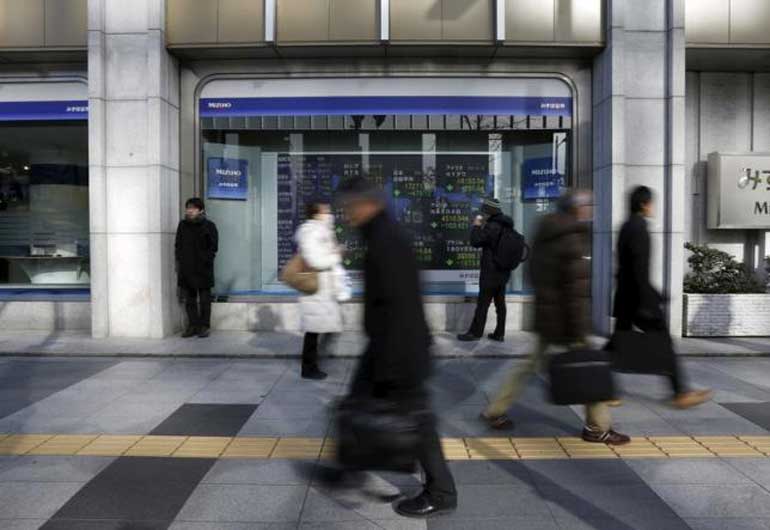Thursday Feb 13, 2025
Thursday Feb 13, 2025
Friday, 5 February 2016 00:00 - - {{hitsCtrl.values.hits}}

Reuters - Asian shares rallied on Thursday as speculation the U.S. Federal Reserve might opt to not raise interest rates at all this year hammered the dollar and sparked a huge rally in oil prices.
By some measures the U.S. currency suffered its largest one-day%age drop outside of the crises of 1998 and 2008, symptomatic of just how crowded bullish positions had been.
The sudden reversal provided a much-needed boost to beleaguered commodities, sending oil up no less than 8%, and easing pressure on energy shares and risk appetite.
That relief showed in equity markets where MSCI’s broadest index of Asia-Pacific shares outside Japan jumped 1.9%. Australia’s resource-heavy index rose 1.7% and South Korea 1%.
In China, the Shanghai Composite Index gained 1.8% as trade wound down ahead of the Lunar holidays. Hong Kong stocks leaped 1.7%, in part because the U.S. dollar’s fall lessened strains on the HK dollar’s peg.
Japanese investors, however, seemed less happy with the yen’s newfound strength against the dollar and nudged the Nikkei down 0.7%.
European shares are expected to rise, with Britain’s FTSE 100 seen rising 0.4% and Germany’s DAX up 0.5%.
Wall Street had taken its cue from oil and recouped early losses on Wednesday, in a wild session that saw the Dow swing in a 420-point range.
The Dow ended Wednesday up 1.13%, while the S&P 500 added 0.5% and the Nasdaq Composite eased 0.28%.
Traders were unsure what triggered the dollar rout though many pointed to comments from Federal Reserve Bank of New York President William Dudley that tighter financial conditions would be taken into account at the next policy meeting in March.
In an interview with Market News International, Dudley also warned that a sharp rise in the dollar could have “significant consequences” for the U.S. economy.
Investors took that to mean the Fed did not want to see the currency rise any further and might delay further increases in interest rates. Futures markets had already priced out almost any chance of a hike in March and imply a funds rate of just 0.51% by December <0#FF:>.
The current effective funds rate is 0.38%.
The impact was amplified by a surprisingly soft reading on the U.S. services sector, just the latest in a string of disappointing economic indicators.
The market reaction was swift and violent with the dollar collapsing through a host of key chart levels and triggering waves of stop-loss selling.
The dollar changed hands at 117.89 yen having shed 1.7% overnight in its biggest daily drop since August.
The fall wiped out all the gains from the Bank of Japan’s decision to cut its rates below zero, a tit-for-tat response that only added to market suspicions central banks were engaged in a war of competitive depreciations.
Against a basket of currencies, the dollar was pinned at 97.351, after shedding 1.6% on Wednesday. The euro was enjoying the view at $1.1087, having climbed 1.7% on Wednesday.
The drop was a boon to commodities priced in U.S. dollars, lifting everything from copper to gold to oil.
Brent futures put on another 30 cents to $35.34 a barrel, on top of a 8.4% gain overnight. U.S. crude added 36 cents to reach $32.64.
Spot gold was up at $1,142.70 an ounce and near its strongest since Oct. 30.
Discover Kapruka, the leading online shopping platform in Sri Lanka, where you can conveniently send Gifts and Flowers to your loved ones for any event including Valentine ’s Day. Explore a wide range of popular Shopping Categories on Kapruka, including Toys, Groceries, Electronics, Birthday Cakes, Fruits, Chocolates, Flower Bouquets, Clothing, Watches, Lingerie, Gift Sets and Jewellery. Also if you’re interested in selling with Kapruka, Partner Central by Kapruka is the best solution to start with. Moreover, through Kapruka Global Shop, you can also enjoy the convenience of purchasing products from renowned platforms like Amazon and eBay and have them delivered to Sri Lanka.
Discover Kapruka, the leading online shopping platform in Sri Lanka, where you can conveniently send Gifts and Flowers to your loved ones for any event including Valentine ’s Day. Explore a wide range of popular Shopping Categories on Kapruka, including Toys, Groceries, Electronics, Birthday Cakes, Fruits, Chocolates, Flower Bouquets, Clothing, Watches, Lingerie, Gift Sets and Jewellery. Also if you’re interested in selling with Kapruka, Partner Central by Kapruka is the best solution to start with. Moreover, through Kapruka Global Shop, you can also enjoy the convenience of purchasing products from renowned platforms like Amazon and eBay and have them delivered to Sri Lanka.